Norwegian-American Greta Nissen (1906–1988) was a blonde bombshell, who appeared in more than 30 films in Denmark, the United States and England. Unfortunately she is now most famous for a role which was re-shot with another actress.
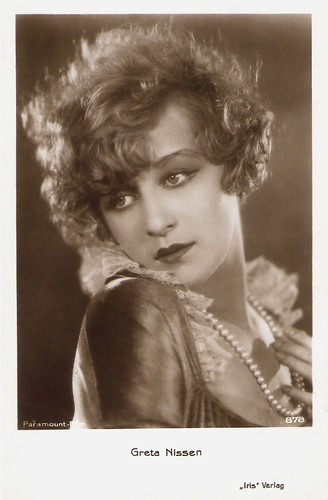
Austrian postcard by Iris Verlag, no. 878. Photo: Paramount-Film.
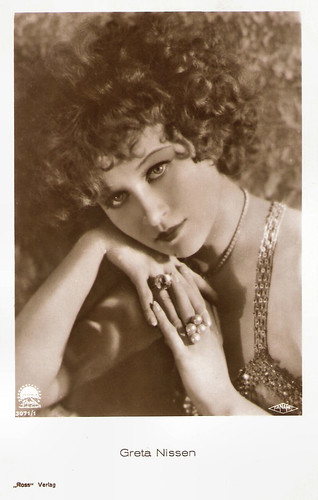
German postcard by Ross Verlag, no. 3071/1, 1928-1929. Photo: Paramount / FaNaMet.
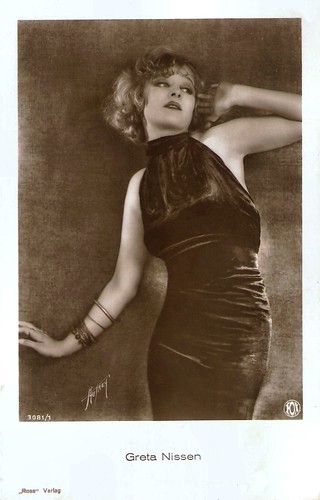
German postcard by Ross Verlag, no. 3081/1, 1928-1929. Photo: Max Munn Autrey / Fox.
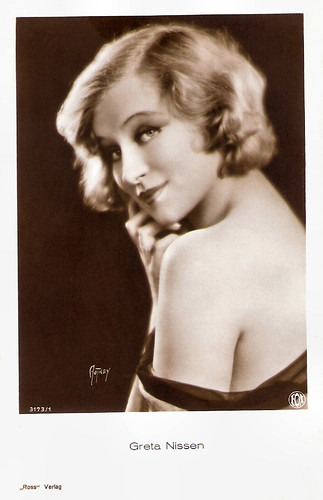
German postcard by Ross Verlag, no. 3173/1, 1928-1929. Photo: Max Munn Autrey / Fox.
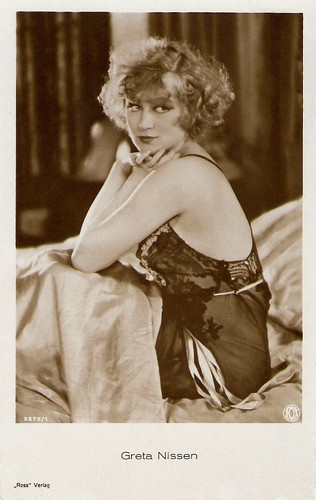
German postcard by Ross Verlag, no. 3575/1, 1928-1929. Photo: Fox.
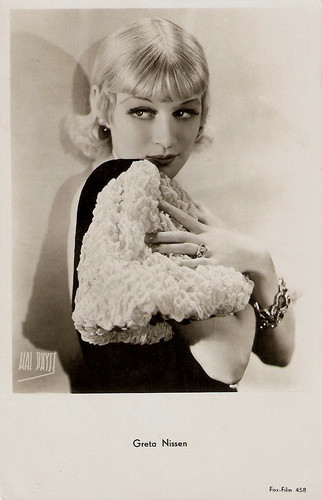
Dutch Postcard, no. 458. Photo: Hal Payfe / Fox Film.
Grethe Rüzt-Nissen was born in Oslo, Norway, in 1906 (some sources say 1905). She was the daughter of Carl Andreas Frantz Nissen and Agnes Magdalene Larsen. After her parents divorced, her mother took her to Copenhagen, Denmark,
In 1911, her mother managed to get Grethe as a student at the Det Kongelige Teater's (Royal Theater) student school, after having 'made' her a year older. Grethe made her stage début as a member of the corps de ballet at the Royal Theater.
Some years later, when the famous choreographer and dancer Mikhail Fokin (or Michel Fokine) came to Denmark after the Russian Revolution, he invited her to come to Paris and she studied with him from 1918 to 1919. In 1922 she performed a series of acclaimed Fokine evenings in Norway.
Grethe made her screen début in the Danish comedies Daarskab, Dyd og Driverter/Folly, Virtue and Idler (Lau Lauritzen, 1924) followed by Lille Lise let-paa-taa/The Little Dancer (Lau Lauritzen, 1924), two vehicles for the comedy team of Fy og Bi (aka Pat & Patachon). These two comedies would be her only films in Scandinavia.
In 1924 she went to New York with a Danish ballet troupe, and there the blonde looker received an offer to appear on Broadway in George S. Kaufman and Marc Connelly's lavish revue Beggar on Horseback. She changed her name to Greta Nissen. Later she worked for the famed Flo Ziegfield in the 1926 production of No Foolin'.
Only 19 years old, she was discovered by Jesse L. Lasky of Paramount Pictures, who signed her to a contract. Making her American screen debut as Greta Nissen in In the Name of Love (Howard Higgin, 1925) with Ricardo Cortez and Wallace Beery, Nissen was singled out by critic Mordaunt Hall of the New York Times, who found her 'an appealing and clever actress with a striking personality'.
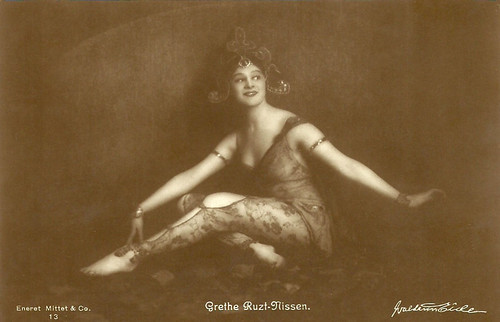
Swedish postcard by Eneret Mittet & Co, no. 13.Collection: Didier Hanson.
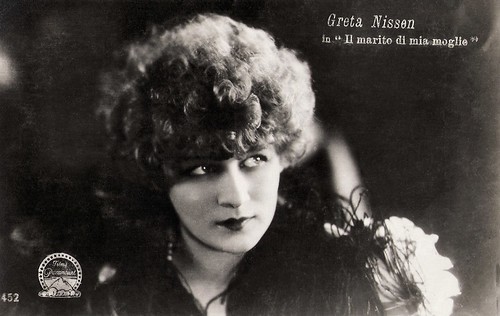
Italian postcard, no. 452. Photo: Films Paramount. Publicity still for Lost: A Wife (William C. de Mille, 1925).

Italian postcard by Casa Editrice Ballerini & Fratini, Firenze (Florence), no. 458. Photo: SAI Filmo Paramount, Roma. Publicity still for The Wanderer (Raoul Walsh, 1925). Collection: Didier Hanson.
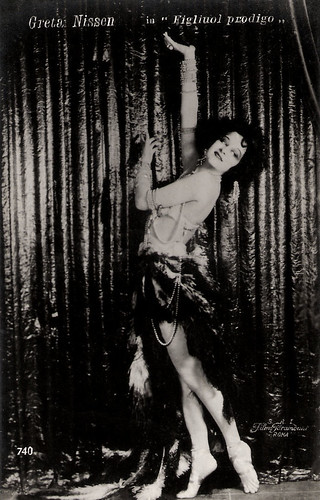
Italian postcard by Casa Editrice Ballerini & Fratini, Firenze (Florence), no. 740. Photo: SAI Filmo Paramount, Roma. Publicity still for The Wanderer (Raoul Walsh, 1925).
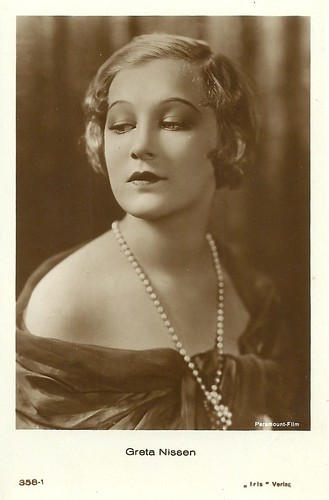
Austrian postcard by Iris Verlag, no. 358/1. Photo: Paramount-Film.
Greta Nissen played in several sophisticated comedies with Adolphe Menjou like The Wanderer (Raoul Walsh, 1925) also with William Collier and Blonde or Brunette (Richard Rosson, 1927).
She became an exotic seductress in such costume extravaganzas as The Lady of the Harem (Raoul Walsh, 1926) and Fazil (Howard Hawks, 1928) opposite Charles Farrell.
MGM, meanwhile, borrowed her for The Love Thief (John McDermott, 1926), to replace Greta Garbo. Among her other successful potboilers were Lost: A Wife (William C. de Mille, 1925), The Lucky Lady (Raoul Walsh, 1926) and The Popular Sin (Malcolm St. Clair, 1926).
In 1927 Nissen was the original choice as the leading lady of Hell's Angels (1930), Howard Hughes’ stunt-flying extravaganza set during World War I. This epic film could have made her a major contender.
Filming was well under way when it was decided that the film would be remade with sound. Unfortunately Greta was replaced because of her heavy Norwegian accent. Nissen had made $2500 a week when filming Hell's Angels and her replacement, Jean Harlow, worked for only $250. The film shot Harlow to stardom and Nissen lost much work due to the advent of sound films.
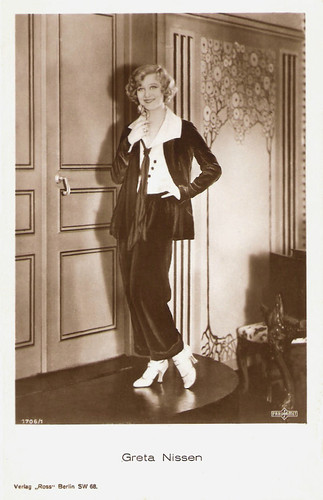
German postcard by Ross Verlag, Berlin, no. 1760/1, 1927-1928. Photo: Parufamet.
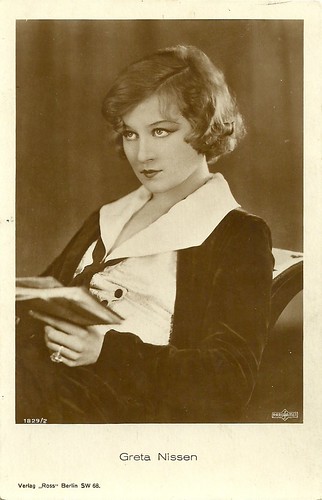
German postcard by Ross Verlag, no. 1829/2, 1927-1928. Photo: Parufamet.
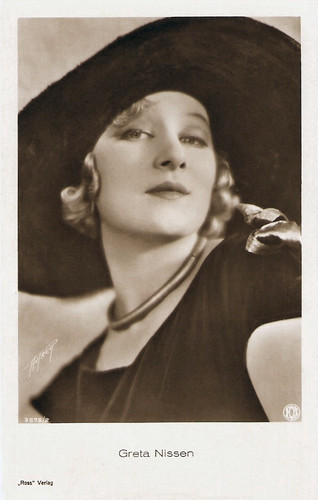
German postcard by Ross Verlag, no. 3575/2, 1928-1929. Photo: Autrey / Fox.
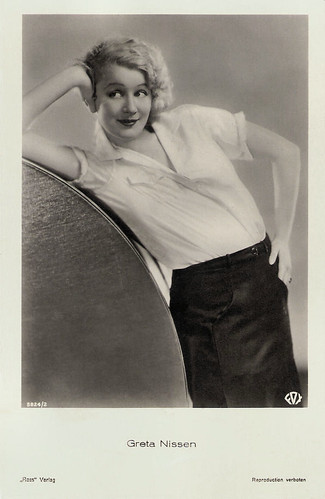
German postcard by Ross Verlag, no. 5824/2, 1930-1931. Photo: Fox.
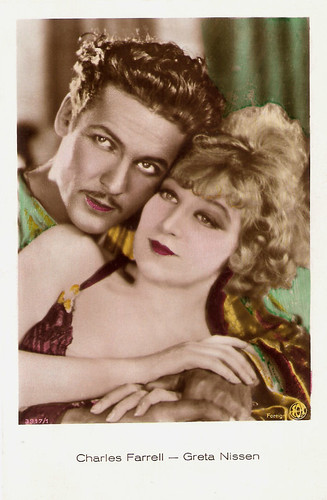
British postcard by Ross Verlag, no. 3917/1, 1928-1929. Photo: Fox. Publicity still for Fazil (Howard Hawks, 1928).
Rebounding somewhat with a contract from Fox, Greta Nissen eventually proved that her accent could easily have been turned into an asset, but the fall-out from the Hell's Angels debacle followed her for the remainder of her film career.
She starred or co-starred in a series of B-films which included the lame Women of All Nations (Raoul Walsh, 1931), the Will Rogers comedy Ambassador Bill (Sam Taylor, 1931), the mystery drama The Circus Queen Murder (Roy William Neill, 1933) again opposite Adolphe Menjou, and the George O'Brien western Life in the Raw (Louis King, 1933).
In 1933 she moved to England where she appeared in a few ‘quota quickies’, including On Secret Service (Arthur B. Woods, 1933) and Honours Easy (Herbert Brenon, 1935) with Margaret Lockwood.
In 1934 she also appeared at the Palace Theatre in London in the original version of Agnes de Mille's ballet Three Virgins and a Devil, performed in the revue Why Not Tonight? After the spy film Cafe Colette (Paul L. Stein, 1937) she retired, and returned to the US.
Divorced from former Fox contract star Weldon Heyburn, Nissen married in 1941 industrialist Stuart Eckert and she lived quietly in California. Greta Nissen died at home in Montecito, California of Parkinson's disease in 1988. She was 82. Her husband said she still received fan letters. Greta had one son, Tor Bruce Nissen Eckert, who in 2005 gave his large collection of Greta Nissen Memorabilia to the Norwegian Emigrant Museum in Ottestad, Norway.
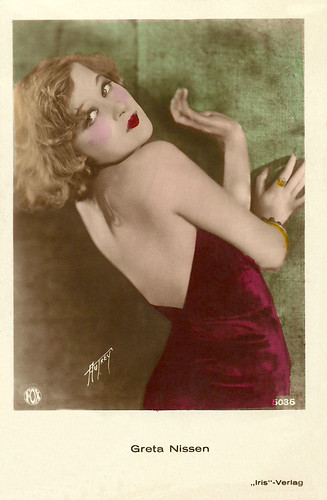
Austrian postcard by Iris Verlag, no. 5035. Photo: Autrey / Fox.
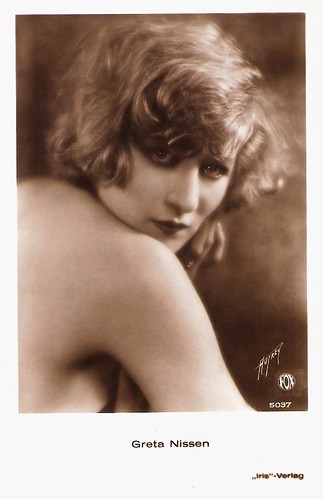
Austrian postcard by Iris-Verlag, no. 5037. Photo: Autrey / Fox.
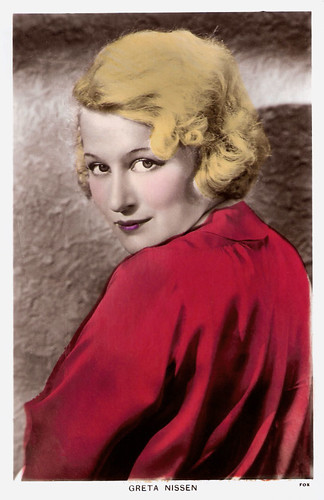
British postcard in the Colourgraph Series, London, no. C 184. Photo: Fox.
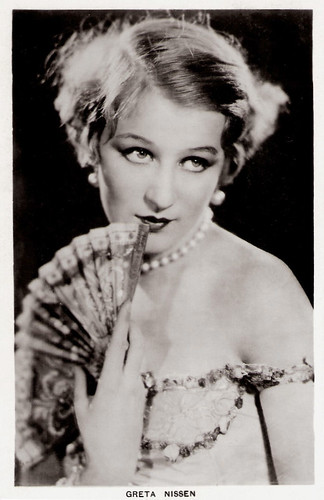
British postcard in the Picturegoer Series, London, no. 264.
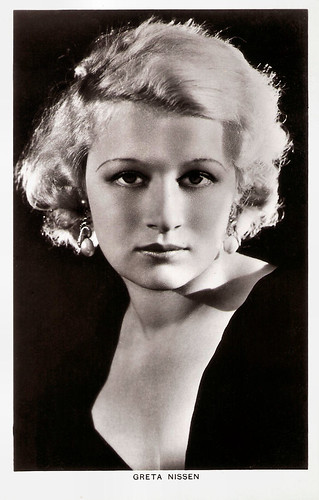
British postcard in the Picturegoer Series, London, no. 264b.
Sources: Hans Otto Christian Arent (Store Norske Lexikon - Norwegian), Hans J. Wollstein (AllMovie), Denny Jackson (IMDb), Allure, Pat M. Ryan (Dance Chronicle), Thomas Staedeli (Cyranos), Wikipedia and IMDb.

Austrian postcard by Iris Verlag, no. 878. Photo: Paramount-Film.

German postcard by Ross Verlag, no. 3071/1, 1928-1929. Photo: Paramount / FaNaMet.

German postcard by Ross Verlag, no. 3081/1, 1928-1929. Photo: Max Munn Autrey / Fox.

German postcard by Ross Verlag, no. 3173/1, 1928-1929. Photo: Max Munn Autrey / Fox.

German postcard by Ross Verlag, no. 3575/1, 1928-1929. Photo: Fox.

Dutch Postcard, no. 458. Photo: Hal Payfe / Fox Film.
Pat & Patachon
Grethe Rüzt-Nissen was born in Oslo, Norway, in 1906 (some sources say 1905). She was the daughter of Carl Andreas Frantz Nissen and Agnes Magdalene Larsen. After her parents divorced, her mother took her to Copenhagen, Denmark,
In 1911, her mother managed to get Grethe as a student at the Det Kongelige Teater's (Royal Theater) student school, after having 'made' her a year older. Grethe made her stage début as a member of the corps de ballet at the Royal Theater.
Some years later, when the famous choreographer and dancer Mikhail Fokin (or Michel Fokine) came to Denmark after the Russian Revolution, he invited her to come to Paris and she studied with him from 1918 to 1919. In 1922 she performed a series of acclaimed Fokine evenings in Norway.
Grethe made her screen début in the Danish comedies Daarskab, Dyd og Driverter/Folly, Virtue and Idler (Lau Lauritzen, 1924) followed by Lille Lise let-paa-taa/The Little Dancer (Lau Lauritzen, 1924), two vehicles for the comedy team of Fy og Bi (aka Pat & Patachon). These two comedies would be her only films in Scandinavia.
In 1924 she went to New York with a Danish ballet troupe, and there the blonde looker received an offer to appear on Broadway in George S. Kaufman and Marc Connelly's lavish revue Beggar on Horseback. She changed her name to Greta Nissen. Later she worked for the famed Flo Ziegfield in the 1926 production of No Foolin'.
Only 19 years old, she was discovered by Jesse L. Lasky of Paramount Pictures, who signed her to a contract. Making her American screen debut as Greta Nissen in In the Name of Love (Howard Higgin, 1925) with Ricardo Cortez and Wallace Beery, Nissen was singled out by critic Mordaunt Hall of the New York Times, who found her 'an appealing and clever actress with a striking personality'.

Swedish postcard by Eneret Mittet & Co, no. 13.Collection: Didier Hanson.

Italian postcard, no. 452. Photo: Films Paramount. Publicity still for Lost: A Wife (William C. de Mille, 1925).

Italian postcard by Casa Editrice Ballerini & Fratini, Firenze (Florence), no. 458. Photo: SAI Filmo Paramount, Roma. Publicity still for The Wanderer (Raoul Walsh, 1925). Collection: Didier Hanson.

Italian postcard by Casa Editrice Ballerini & Fratini, Firenze (Florence), no. 740. Photo: SAI Filmo Paramount, Roma. Publicity still for The Wanderer (Raoul Walsh, 1925).

Austrian postcard by Iris Verlag, no. 358/1. Photo: Paramount-Film.
Hell's Angels
Greta Nissen played in several sophisticated comedies with Adolphe Menjou like The Wanderer (Raoul Walsh, 1925) also with William Collier and Blonde or Brunette (Richard Rosson, 1927).
She became an exotic seductress in such costume extravaganzas as The Lady of the Harem (Raoul Walsh, 1926) and Fazil (Howard Hawks, 1928) opposite Charles Farrell.
MGM, meanwhile, borrowed her for The Love Thief (John McDermott, 1926), to replace Greta Garbo. Among her other successful potboilers were Lost: A Wife (William C. de Mille, 1925), The Lucky Lady (Raoul Walsh, 1926) and The Popular Sin (Malcolm St. Clair, 1926).
In 1927 Nissen was the original choice as the leading lady of Hell's Angels (1930), Howard Hughes’ stunt-flying extravaganza set during World War I. This epic film could have made her a major contender.
Filming was well under way when it was decided that the film would be remade with sound. Unfortunately Greta was replaced because of her heavy Norwegian accent. Nissen had made $2500 a week when filming Hell's Angels and her replacement, Jean Harlow, worked for only $250. The film shot Harlow to stardom and Nissen lost much work due to the advent of sound films.

German postcard by Ross Verlag, Berlin, no. 1760/1, 1927-1928. Photo: Parufamet.

German postcard by Ross Verlag, no. 1829/2, 1927-1928. Photo: Parufamet.

German postcard by Ross Verlag, no. 3575/2, 1928-1929. Photo: Autrey / Fox.

German postcard by Ross Verlag, no. 5824/2, 1930-1931. Photo: Fox.

British postcard by Ross Verlag, no. 3917/1, 1928-1929. Photo: Fox. Publicity still for Fazil (Howard Hawks, 1928).
B-films and Quota Quickies
Rebounding somewhat with a contract from Fox, Greta Nissen eventually proved that her accent could easily have been turned into an asset, but the fall-out from the Hell's Angels debacle followed her for the remainder of her film career.
She starred or co-starred in a series of B-films which included the lame Women of All Nations (Raoul Walsh, 1931), the Will Rogers comedy Ambassador Bill (Sam Taylor, 1931), the mystery drama The Circus Queen Murder (Roy William Neill, 1933) again opposite Adolphe Menjou, and the George O'Brien western Life in the Raw (Louis King, 1933).
In 1933 she moved to England where she appeared in a few ‘quota quickies’, including On Secret Service (Arthur B. Woods, 1933) and Honours Easy (Herbert Brenon, 1935) with Margaret Lockwood.
In 1934 she also appeared at the Palace Theatre in London in the original version of Agnes de Mille's ballet Three Virgins and a Devil, performed in the revue Why Not Tonight? After the spy film Cafe Colette (Paul L. Stein, 1937) she retired, and returned to the US.
Divorced from former Fox contract star Weldon Heyburn, Nissen married in 1941 industrialist Stuart Eckert and she lived quietly in California. Greta Nissen died at home in Montecito, California of Parkinson's disease in 1988. She was 82. Her husband said she still received fan letters. Greta had one son, Tor Bruce Nissen Eckert, who in 2005 gave his large collection of Greta Nissen Memorabilia to the Norwegian Emigrant Museum in Ottestad, Norway.

Austrian postcard by Iris Verlag, no. 5035. Photo: Autrey / Fox.

Austrian postcard by Iris-Verlag, no. 5037. Photo: Autrey / Fox.

British postcard in the Colourgraph Series, London, no. C 184. Photo: Fox.

British postcard in the Picturegoer Series, London, no. 264.

British postcard in the Picturegoer Series, London, no. 264b.
Sources: Hans Otto Christian Arent (Store Norske Lexikon - Norwegian), Hans J. Wollstein (AllMovie), Denny Jackson (IMDb), Allure, Pat M. Ryan (Dance Chronicle), Thomas Staedeli (Cyranos), Wikipedia and IMDb.
No comments:
Post a Comment